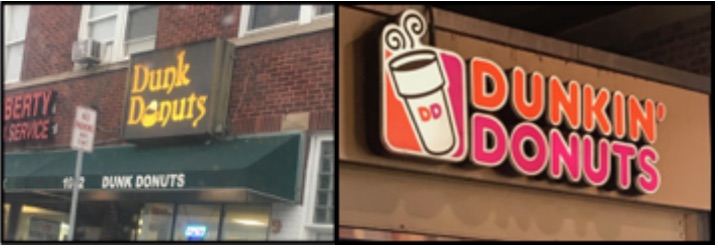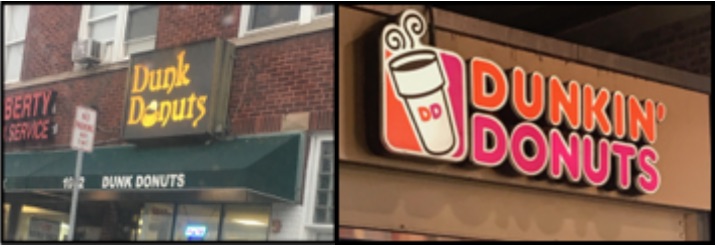IP Here, IP There…IP Everywhere
IP is everywhere and affects everyone. This principle was reinforced when I took Intellectual Property Law with Professor Ho during the Fall 2018 semester. We regularly had examples in class regarding the many ways IP intersects with everyday life, even including a copyright infringement case involving Kanye West. There were more examples at the end of the semester when students presented real and/or realistic applications of IP law. I especially enjoyed working on my final presentation with Jessica Fenton involving a local mom-and-pop donut shop called “Dunk Donuts.” If you’re thinking that sounds like Dunkin’ Donuts, so were we—and wondering whether this Oak Park donut shop might be liable to the national donut chain.
What’s in a Name?
The first liability issue was whether Dunk Donuts infringed on Dunkin’ Donuts’ trademark in its name. A trademark can include brand names and logos so long as they are used in commerce to identify the source of goods and are distinctive. The brand “Dunkin’ Donuts” would seem to identify that the donuts come from that store, as opposed to other donut shops, like Stan’s Donuts, or even donuts from a non-specialty store, like Jewel-Osco. But, is it distinctive? Basically, this means that the trademark distinguishes the good from others. Dunkin’ Donuts signifies to consumers that its donuts are not made by others, such as Krispy Kreme. However, not all distinctive trademarks are the same. There are different categories of trademark distinctiveness, with stronger ones getting more protection against unauthorized uses. The hierarchy of distinctive marks is as follows:
- Fanciful or arbitrary (most protection)
- Suggestive
- Descriptive (least protection; only qualifies in some situations)
For our project, we categorized the trademark “Dunkin’ Donuts” as suggestive. Suggestive marks suggest some particular characteristic of the good or service to which it applies. These marks require the customer’s imagination to draw a conclusion to the nature of the good or service.
You may be wondering why Dunkin’ Donuts did not rise to either fanciful or arbitrary categorization. A fanciful trademark uses words or images that do not have any prior meaning. For instance, Xerox is a word without any existing meaning and is used by the company of the same name that sells printers, toners and cartridges. An arbitrary trademark is a word or image already existing that has nothing to do with the business that uses it. For example, Apple’s products, like laptops or iPhones, have nothing to do with the fruit.
To Register or Not To Register (at the USPTO)
Importantly, Dunkin’ Donuts is not just a valid trademark, but a federally registered one. What does that mean? If you have ever seen a “®” following a word, name, symbol, or device describing a good or service, that indicates it is a federally-registered trademark. Federal trademark registration is not mandatory. However, by registering your trademark with the United States Patent and Trademark Office (USPTO), you obtain advantages over those who do not. In particular, although any trademark can be valid without registration, a federally registered trademark entitles you to a presumption of validity in litigation. In addition, you can possibly bar anyone in the entire U.S. from using the same mark if it would result in likelihood of confusion. That said, there is an important caveat that is important to our donut tale. Since trademarks exist based solely on use, the first user of a trademark cannot have violated a later-registered trademark.
Likelihood of Confusion
Dunkin’ Donuts would like to show that there would be a likelihood that consumers would be confused between its stores and Dunk Donuts. If the nationwide chain succeeds in showing such likelihood of confusion, Dunk Donuts has infringed Dunkin’ Donuts’ trademark.

To assess likelihood of confusion when analyzing potential trademark infringement, various factors can come into play, including the strength of the trademark and whether the goods are so related or similar to one another that customers could confuse the two. These factors would seem to spell disaster for Dunk Donuts. After all, the words “Dunk Donuts” are only a few letters away from “Dunkin’ Donuts.” Even more, take a close look at the Dunk Donuts photo. The “Dunk Donuts” written in white font is quite similar to that of Dunkin’ Donuts recognizable Comic Sans-like font. Now, you may be thinking, “Well, I guess that’s it for Dunk Donuts.” Not so fast!
First Come, First Trademark
Dunkin’ Donuts registered its trademark while Dunk Donuts did not. However, despite the similarities that might get Dunk Donuts in trouble, Dunk Donuts would not infringe. Why? This is because Dunk Donuts opened its Oak Park shop before the nationwide chain registered its trademark in 1960, and thus used the word “Dunk Donuts” in commerce before the federally-registered “Dunkin’ Donuts.” So, first come, first trademark applies.
However, this does not mean that Dunk Donuts can freely open new donut shops nationwide, outside of its Oak Park location. Although it will not infringe on Dunkin’ Donuts’ federally-registered trademark in its local territory of Oak Park, it will likely infringe if it opens stores in areas outside of the local Oak Park community, due to the protection afforded to the national chain’s trademark. Not to worry, because our Dunk Donuts’ owners pride themselves in their mom-and-pop shop and don’t desire to open in any other location but good ol’ Oak Park!
This is just one of several issues that we focused on in our presentation. But, hopefully this helps to show how trademarks exist in real life and why companies, including local mom-and-pop ones, should know about them. Although Dunk Donuts may not want to expand, for any other business that wants to reserve the right for expansion, this tale of two donut shops highlights why knowing about trademarks and seeking registration is important.
Images by Carrie Park. No Rights Reserved.

Carrie Park
Associate Blogger
Loyola University Chicago School of Law, J.D. 2020
